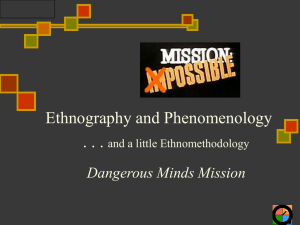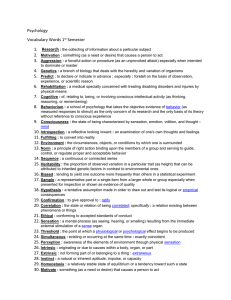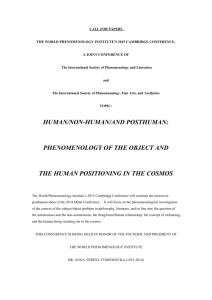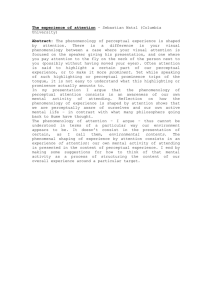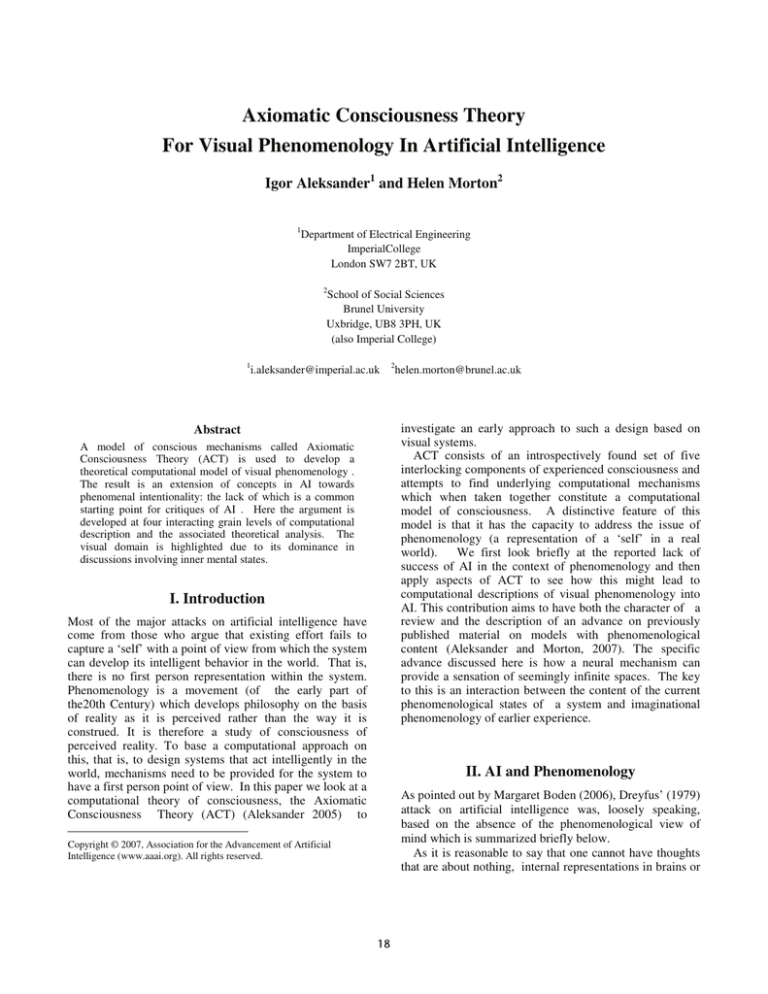
Axiomatic Consciousness Theory
For Visual Phenomenology In Artificial Intelligence
Igor Aleksander1 and Helen Morton2
1
Department of Electrical Engineering
ImperialCollege
London SW7 2BT, UK
2
School of Social Sciences
Brunel University
Uxbridge, UB8 3PH, UK
(also Imperial College)
1
i.aleksander@imperial.ac.uk
2
helen.morton@brunel.ac.uk
investigate an early approach to such a design based on
visual systems.
ACT consists of an introspectively found set of five
interlocking components of experienced consciousness and
attempts to find underlying computational mechanisms
which when taken together constitute a computational
model of consciousness. A distinctive feature of this
model is that it has the capacity to address the issue of
phenomenology (a representation of a ‘self’ in a real
world).
We first look briefly at the reported lack of
success of AI in the context of phenomenology and then
apply aspects of ACT to see how this might lead to
computational descriptions of visual phenomenology into
AI. This contribution aims to have both the character of a
review and the description of an advance on previously
published material on models with phenomenological
content (Aleksander and Morton, 2007). The specific
advance discussed here is how a neural mechanism can
provide a sensation of seemingly infinite spaces. The key
to this is an interaction between the content of the current
phenomenological states of a system and imaginational
phenomenology of earlier experience.
Abstract
A model of conscious mechanisms called Axiomatic
Consciousness Theory (ACT) is used to develop a
theoretical computational model of visual phenomenology .
The result is an extension of concepts in AI towards
phenomenal intentionality: the lack of which is a common
starting point for critiques of AI . Here the argument is
developed at four interacting grain levels of computational
description and the associated theoretical analysis. The
visual domain is highlighted due to its dominance in
discussions involving inner mental states.
I. Introduction
Most of the major attacks on artificial intelligence have
come from those who argue that existing effort fails to
capture a ‘self’ with a point of view from which the system
can develop its intelligent behavior in the world. That is,
there is no first person representation within the system.
Phenomenology is a movement (of the early part of
the20th Century) which develops philosophy on the basis
of reality as it is perceived rather than the way it is
construed. It is therefore a study of consciousness of
perceived reality. To base a computational approach on
this, that is, to design systems that act intelligently in the
world, mechanisms need to be provided for the system to
have a first person point of view. In this paper we look at a
computational theory of consciousness, the Axiomatic
Consciousness Theory (ACT) (Aleksander 2005) to
II. AI and Phenomenology
As pointed out by Margaret Boden (2006), Dreyfus’ (1979)
attack on artificial intelligence was, loosely speaking,
based on the absence of the phenomenological view of
mind which is summarized briefly below.
As it is reasonable to say that one cannot have thoughts
that are about nothing, internal representations in brains or
Copyright © 2007, Association for the Advancement of Artificial
Intelligence (www.aaai.org). All rights reserved.
18
their models must be about something. That is, they need
to be intentional (Brentano, 1874). The representation has
to have the detail of the object itself and interactions the
organism can have with it (Husserl, 1913). Another
classical objection by Searle (1992) known as the Chinese
Room Argument applies to the lack of phenomenology in
symbolic systems. But what is a symbol? Generally it is a
mark (or a variable in a computer) that ‘stands for
something’. So symbol C could stand for ‘cat’ and in order
to approach some form of intentional representation,
cognitive scientists have created semantic networks which
as in ‘C <has> 4P’ or ‘C<has> four-paws’ attempts to
capture the ‘aboutness’ or intentionality of symbol C.
According do Searle this fails unless the symbol is
shorthand for other mental, experiential representation.
However were the mark on the piece of paper a good
picture of a cat, it could act instead of the semantic
network in, say, driving a robot appropriately in a real
world containing a cat. In this paper we define fine-grain
neural representations (that is, symbols as fine-grain
marks) that are better candidates for visual phenomenology
than classical computational symbols.
Twentieth century thought on phenomenology extended
‘aboutness’ to experiences of one’s own body (MerleauPonty, 1945) and the existence of the body as a ‘self’ in
some containing environment (Heidegger, 1975). Positive
suggestions that approach phenomenology in a
computational system were first indicated by
connectionists (e.g. Rumelhart and McClelland, 1986)
where distributed representations were favored over
symbolic ones. In this paper we argue that, to be
phenomenological,
representations
are
necessarily
distributed, but also, they need to represent the process of
controlling the interaction of an organism with its
environment. Harnad (1990) pointed out that distal
representation of the world should be included in order to
‘ground’ the symbolic system within a computational
model. But, generally, a phenomenological system would
be expected to develop its behavior from its own,
introspective representation of the world.
Symbol
grounding develops its behavior from the symbolic
algorithms even in Harnad’s grounded systems.
More pertinently, Varela (1996) coined the term
Neurophenomenology to initiate studies on the way inner
sensations of the world might be represented in the brain.
Lutz and Thomson (2003) relate this to the accuracy of
introspective data and show that considering potential
brain representation reduces the ‘gap’ between first person
and third person data although this is hardly done in the
context of AI.
Dunmall, 2003 – here called Axioms) this was done by
quoting high level non-operative relations involved in five
introspectively derived axioms (presence, imagination,
attention, volition and emotion). In this paper we take the
opportunity of presenting a new operational analysis of
these relations in the context of neural aspects of AI.
Why ‘Neural’? By introspection, the primary sensation
for which we wish to find a computational model is one of
being in a space which is an unvarying reality made up of
detail. In Axioms we suggested that there was a ‘minimal
world event’ of which we could be conscious probably
through multiple senses. While in Axioms we argued that
the world is made up of such minimal events, here we feel
that this is wrong – it is the perceiving mechanism that
provides the sensation of this fine grain world. The reason
is that the minimal event of which we can become
conscious is determined by the graininess of the machinery
of the brain. In the brain it is a matter of neurons. In a
computational system could it be the pixel of a stored
image? We strenuously argue that this cannot be the case
as these pixels need to take part in a dynamic process
which underpins the ACT as described below. So in a
computational system too it becomes a matter of a finegrained cellular system for which a neuron model is an
obvious candidate. Below, we briefly examine the axioms
in Axioms to maintain a complete foundation for this paper
and introduce a progression towards a phenomenological
system..
Axiom 1: Presence.
In Axioms it is noted that a
sensation of presence may be modeled by making use of
the existence of neurons that are indexed on signals from
muscles as is known to occur in brains. In this paper we
extend this notion to show how large visual fields can be
accommodated to obtain a new formulation for visual
phenomenology.
Axiom 2: Imagination.
In Axioms, the sensation of
recall of meaningful experienced scenes is modeled
through getting the machinery of axiom 1 both to create
the states and the transitions between states in a separate
recursive neural system that can then enter perceptually
meaningful inner states even in the absence of perceptual
input. Here we also extend this to dealing with continuous
memories of experienced spaces.
Axiom 3: Attention. In Axioms, attention is presented
as the introspective feeling of selecting input in the
process of building up a sensation (visual in the examples
given). It is modeled by mimicking the actions of the
superior colliculus in the brain, which causes the eye fovea
to move to areas of high spatial frequency or changes with
time in the visual scene. Here we assume that attention is a
mechanism that controls the division between restricted
III. ACT and AI: a résumé
This paper concerns formalizing the ‘gap’ between first
and third person visual experience in the context of AI.
While ACT was first enunciated in 2003 (Aleksander and
19
phenomenological states and transitions between such
states (both in perception and imagination) that leads to
fuller phenomenological sensations.
Axiom 4/5: Volition/Emotion.
In Axioms we
introduced a way of traversing the content of axiom 2
imaginative machinery that is controlled by an affective
evaluation of imagined outcomes of actions. This is not
pursued further in the current paper.
IV. Defining levels of visual sensation.
We now address the central aim of this paper: the
apparently unlimited nature of visual phenomenology.
Imagine entering a space that has not been experienced
before such as, for example, the Houses of Parliament in
London.
It must be recognized that the overall
phenomenological visual experience is made up of
different elements which we delineate as follows.
Space Sensation is the sensation described from
introspection as being in a substantial location (e.g. of
being in the Houses of Parliament). We assert that the
sensation of space is that which requires the movement of
the body for its completion. Another example is ‘knowing
what is behind one’ where one can turn around to look but
then remains in one’s sensation.
Frontal Sensation is the sensation that would be described
as ‘being in front of me’. For example, “the entrance to the
Commons debating chamber is in front of me as is the
functionary who is controlling access”. We assert that
frontal sensation is that which requires muscular
movement of the head and torso without locomotion.
Eyefield Sensation is that which can be experienced
without head movement. It is that which is acquired by
eye movement, that is, movement of the foveal content of
vision without head movement.
Foveal View is generally not in complete conscious
experience (Crick and Koch, 1998) but is still present in
the primary visual cortex to be brought into consciousness
as an eyefield sensation deeper in the visual sysem as
explained below.
Figure 1: A ‘kernel architecture (reproduced from
Aleksander and Morton, 2006). This shows how the
responsibility for implementing the axiomatic mechanisms
is distributed across four neural areas.
This is posited to occur because the signals from the
muscular actions produce signals which are used to index
neurons according to the position of the foveal view within
the eyefield area. In other words the eyefield sensation
exists as a state in the perceptual module of a ‘kernel’
architecture shown in figure 1.
In other words, the dotted line between action neurology
and the perceptual module controls which state variables
in the latter are influenced by the content of a foveal
image. The only memory requirement for the perceptual
module is that it holds the positioned foveal image for long
enough during a fading process for the eyefield image to be
created. As the eyefield representation mirrors reality it has
been called depictive in other publications (e.g. Aleksander
2005)
V. System needs.
In the published ACT so far, it is the transition between
the foveal view and the eyefield sensation that is
addressed.
Figure 2: A ‘frontal’ sensation with a superimposed grid..
20
VI. Frontal sensation memory.
Now consider head movement. In previous work, it was
assumed that a process similar to the above was at work.
However, this must be questioned for two reasons. First,
despite the vastness of available neural tissue in the brain,
representing a whole history of eyefield images in a space
somatotopically related to real space has a lack of economy
that is unlikely and needs to be examined for alternatives.
Second, this kind of representation has no clear point of
view, and this too needs examining.
While the method is entirely proper for an eyefield
representation (with the reference point in the centre of the
eyefield being indicative of the pointing direction of the
head) it does not align with introspection of the visual
sensation which is of being at the centre of a space larger
than that subtended by the eyefield.
The strategy we propose here is to cast the
representation of physical space into state space. For
example consider the image in figure 2. The whole figure
is a candidate for a 2-D frontal sensation. In figure 3, this is
decomposed into a set of states where each state is an
eyefield sensation in turn made up of nine foveal
sensations. Looking again at figure 1 we impose a
division of labour. As indicated, the main role for the
perceptual module (PM) is to create the eyefield
representation responsible for the eyefield sensation
(relationships between sensation and representation are
discussed at length in Aleksander, 2005). This corresponds
to a group of 3x3 foveal representations. Now, it is the
task of the memory module (MM) of figure 1 to provide
the memory of previous eyefield representations so as to
lead to a representation that aligns with the frontal
sensation.
The task for the memory module is to create a state space
akin to figure 3 or some subset of it (the system may not
explore the entire space and hence learn it). To begin a
process of reverse engineering, let the current eyefield
representation in PM be E1 . Let the action (head
movement) that takes place alongside this representation
be A1 . This leads to a new state E2 and action A2 And so
on. We posit that such (Ej , Aj) pairs act input to MM. Here
we evoke an ‘iconic transfer’ (Aleksander and Morton,
1995). Briefly, in an iconic transfer it is assumed that the
input and state have the same dimensions and that the
learned state is a reproduction of the input. Hence where
the general training of a neural state machine is
(im, sk)t ĺ (sj) t+1
.
(1)
(im, sk)t being the current input/state pair and (sj) t+1 being
the next state that is learned for the current pair, for iconic
transfer learning this becomes
(im, sk)t ĺ (im) t+1
(2)
This implies that starting with a specific state sk the input im
is recognised through evoking a state representation of
itself in full detail. Returning to the situation for MM,
during the running of the process, (2) becomes:
((Ej , Aj ), (Ek , Ak)) t ĺ (Ej , Aj ) t+1 ,
(3)
where the E symbols relate to eyefields and the A symbols
to action symbols. Equation 3 indicates that the net
anticipates an (eyefield, action) pair at t+1 given the
previous stored pair and the currently experienced pair.
It is further commonplace to make use of the
generalization properties of this type of digital neural state
machine (also in Aleksander and Morton 1995). That is,
given a training sequence of [input (T)/ output (Z)] pairs
for a single layer net T1ĺ Z1, T2ĺ Z2, …… Tnĺ Zn ,
then given some unknown input Tu the response will be
Zr, where Trĺ Zr is the training step for which Tr is the
pattern closest in Hamming distance to Tu . If the
‘closensess’ is in contention (as there may be several
candidates with different outputs at the closest Hamming
distance) then one of the contenders is selected at random
(the details of this are beyond the scope of this paper).
Returning to the system and its exploration of the visual
world through head movement , we note that (3) indicates
that MM will build up a state structure such as in figure 3,
understanding that the arrows represent the As and the 3x3
images are the Es. It has to be understood further that
formulation in (3) is in terms of a Moore automaton. That
is, in figure 3, each image and arrow pair is a state. We
note that only up/down transitions are shown. There could
be actions in many more directions.
Figure 3: State space decomposition
21
Several effects now can be noted.
1. The more the system explores the frontal image,
the more complete becomes the representation of
the frontal image in MM. Total completion is
only asymptotically achieved.
2. Say that the system (for some reason) stops
exploring . Ths means that the action module is in
some inactive state we call Φ. Then (3), due to
generalization could become any of these:
((Ej , Φ ), (Ek , Ak)) t ĺ (Ej , Aj ) t+1
ĺ (Ej, Aa ) t+1
ĺ (Ej, Ab ) t+1
…………….
…………….
where the multiplicity of mappings occurs due to
the fact that many actions may have been learned
for one frontal state. According to the
generalization rule any one of these might be
entered if the perception persits. In other words,
experiencing a particular eyefield state leads MM
to explore other eyefields that resulted from head
movement
3. By similar reasoning, if neither the action nor the
eyefield from PM constitute a meaningful pattern
into MM (eyes closed, say), MM is can become
free to ‘move’ around the frontal field. This is
due to the fact that through the Eyefield/Action
pairs the MM ‘knows' what head movement is
involved in the changes of eyefield patches.
Indeed, appropriate movement machinery can be
driven by the action part of the states in MM to
execute an imagined movement.
Therefore, to summarise, frontal phenomenological
representation consists of a state-space structure of states
that are localized foveal views connected by links that
correspond in magnitude and direction to head
movement.are related. Here we can define a parameter that
will be useful later: let FX be the frontal state structure
associated with the head being in a normal position with
respect to the body and with the body in some position x.
We can, indeed, associate normal eyefield and foveal
positions EX GX from which eye movement and head
movement can be measured with the body in position x.
We return to this after considering a toy simulation.
Fig. 1. In this iconic neural state machine, both the visual state
and the organism movement are imagined. The imagined moves
are generated at random as no move sequence has been learned. It
is noted that when the system tries to imagine an impossible
move (e.g. left from the leftmost position) the system simply
stands still.
In figure 4 the letters are the foveal area while a group of three
letters is an eyefield view. Then the frontal view is shown as
‘world’. The eyefield view can be moved by one letter space at a
time. There is no perceptual module here so the iconic state
machine was trained by forcing states on the input of the machine
as if they had come from a perceptual module. During training,
the eyefield window was moved across the world from centre to
limit and back to centre, repeated for the other limit. Then the
system was started in an arbitrary (noise) state from which it
found a meaningful eyefield state before ‘exploring’ (through the
dynamics of ‘attraction’) its learned world which includes
movement in that world.
VIII. Space sensation
Earlier we defined the space sensation as that which
requires locomotion. For example, say that a frontal
representation is obtained for the organism facing North.
We use the notion of a normal head position and refer to
the frontal representation garnered in this position FN .
Now say that the organism turns its body through 180
degreees and faces South. Here it builds a frontal
representation, FS . The question that now has to be faced
is how might FN and FS be related in the MM? Clearly, the
action signals that cause the locomotion can be
distinguished from those that cause head movement. So
during the buildup of depictive states in the MM an action
input becomes associated with a change from a state in FN
to one in FS. Many such links may be created between
these two sets of states, so that the knowledge in the MM
corresponds to thinking ‘if I face North this is what I will
see, but if I turn to South I shall see this other scene’. Note,
that due to the freedom with which the MM can run
VII. Simulation.
While major simulations of all four levels of
phenomenology integrated into a single system are work in
progress, here we present a toy simulation that illustrates
the way that a scene viewed by a moving sensor can be
represented in an MM-like mechanism.
22
through its state structure, the organism can ‘imagine’ what
is at the back of its head while it is also perceiving what is
in front of it.
In summary, spaces visited by the organism are
represented phenomenologiclly as Frontal sensations, but
are related by transitions that represent the locomotion that
causes transition learning in the MM.
References
Aleksander, I.: 2005, The World in my Mind, my Mind in
the World: Key Mechanisms of Consciousness In
Humans, Animals and Machines. Exeter: Imprint
Academic
Aleksander, I. and Dunmall, B.: 2003, Axioms and Tests
for the Presence of Minimal Consciousness in Agents.
Journal of Consciousness Studies,10, 4-5, pp. 7-19
Aleksander, I and Morton, H. B.: 1995, Introduction to
Neural Computing 2nd Ed, London, ITCP.
Barrett, D., Kelly, S. and Kwan, H.: 2000,
Phenomenology, Dynamical Neural Networks and Brain
Function, Philosophical Physiology, 13, 213 – 226.
Aleksander,I. and Morton H. B.: 2007, Depictive
Architectures for Synthetic Phenomenology, In Chella
and Manzotti, (Eds): Artificial Consciousness. Imprint
Academic, pp.30-45
Boden, M.: 2006, Mind as Machine, Oxford University
Press (p 1394)
Crick, F. and Koch, C.: 1998 Consciousness and
Neuroscience. Cereb Cortex. 8(2):97-107
Brentano, F.: 1874, Psychology from an Emptirical
Standpoint, Trans: Rancurello et al.Routledge (1995)
Orig in German .
Harnad, S.: 1999, The Symbol Grounding System Physica
D 42: 335-346
Heidegger, M.: 1975, The Basic Problems of
Phenomenology, Trans Hofstadter, Indiana University
Press, Orig in German.
Lutz, A. and Thompson E.: 2003, Neurophenomenology:
integrating subjective experience and brain dynamics in
the neuroscience of consciousness. Journal of
Consciousness Studies, 10, No. 9–10, pp. 31–52
Merleau-Ponty, M.: 1945, Phenomenology of Perception,
Trans Smith, Routledge (1996), Orig in French.
Paillard, J. (ed): 1991, Brain and Space Oxford: Oxford
University Press.
Rumelhart, D. and McCelland, J.: 1986, Parallel
Distributed Processing, Cambridge,Mass. MIT Press.
Searle, J. 1992,: The Rediscovery of the Mind, Cambridge,
Mass. MIT Press
Varela, F.J. 1996, ‘Neurophenomenology: A
methodological remedy to the hard problem’, Journal of
Consciousness Studies, 3 (4), pp. 330–50.
IX. Concluding commentary
What has been achieved?
From introspective
considerations we have distinguished between four visually
phenomenological sensations that require individual
mechanisms that need to be integrated to provide a
complete visual phenomenology. These are the foveal
image, the eyefield image created by eye movement, the
frontal image created by head and body movement while
standing still and the space image created by locomotion.
It has been shown that this representation includes the
actions that need to be taken and concurs with notions of
phenomenology sketched in earlier parts of the paper. As a
lack of phenomenology is the criticism often leveled at
artificial intelligence we submit that the Axiomatic
Consciousness Theory concepts used here take AI forward
towards phenomenology.
What has not been achieved?
Except for a toy
simulation, what is reported in this paper is purely a
feasibility study for a fully structured system that
demonstrates the potential mechanisms discussed here.
What kind of science is this?
The process of reverse
engineering of cognitive functions takes inspiration from
mechanisms that are thought to be at work in the brain and
tries to discover some theoretical operating principles that
underlie these. In this paper the expression of such
theoretical principles has been that of probabilistic neural
state machines. The task for the researcher is then to build
systems based on such principles to confirm the
plausibility of the posited mechanisms. We note the
specific concern with mechanism distinguishes this work
from traditional AI where the accent is more on external
behaviour.
Phenomenology and cognition. Finally, it is important
to note that a vast corpus of literature exists that concerns
explanations of phenomenology of space perception in the
brain rather than its computational models. This is
exemplified by older publications such as Paillard, 1991 or
more recent papers such as Barrett et al. 2000 which,
indeed, make use of the properties of neural networks.
Further work is needed along the lines indicated in this
paper and the observations of cognitive psychology should
be examined in this context.
23

